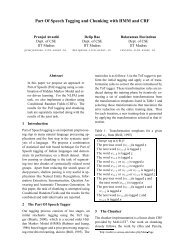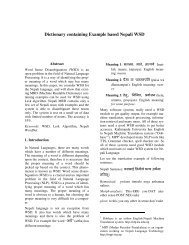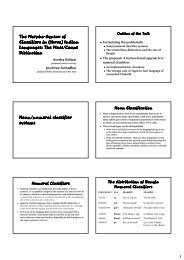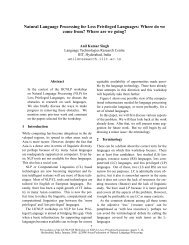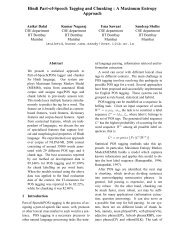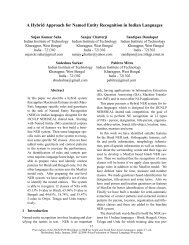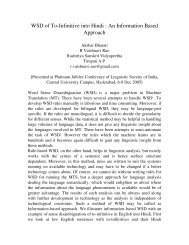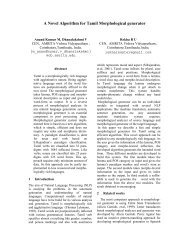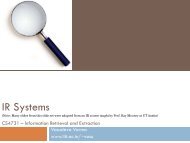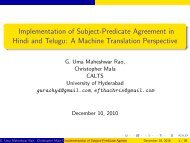SSF Format Doc - LTRC Home - IIIT Hyderabad
SSF Format Doc - LTRC Home - IIIT Hyderabad
SSF Format Doc - LTRC Home - IIIT Hyderabad
Create successful ePaper yourself
Turn your PDF publications into a flip-book with our unique Google optimized e-Paper software.
3 Sentence Level <strong>SSF</strong><br />
3.1 Background<br />
Sentence level <strong>SSF</strong> is used to store the analysis of a sentence. It occurs as part of text level<br />
<strong>SSF</strong>. The analysis of a sentence may mark any or all of the following kinds of information<br />
as appropriate: part of speech of the words in the sentence; morphological analysis of the<br />
words including properties such as root, gender, number, person, tense, aspect, modality;<br />
phrase-structure or dependency structure of the sentence; and properties of units such as<br />
chunks, phrases, local word groups, bags, etc. Note that <strong>SSF</strong> is theory neutral and allows<br />
both phrase structure as well as dependency structure to be coded, and even mixed in<br />
well defined ways.<br />
Several formalisms have been developed for such descriptions but the two main ones in<br />
the field of NLP are Phrase Structure Grammar (PSG) and Dependency Grammar (DG).<br />
In PSG, a set of phrase structure rules are given for the grammar of a language. It is<br />
constituency based and order of elements are a part of the grammar, and the resulting tree.<br />
DG, on the other hand, is relational and shows relations between words or elements of a<br />
sentence. It, usually, tries to capture the syntactico-semantic relations of the elements in<br />
a sentence. The resulting dependency tree is a tree with nodes and edges being labelled.<br />
The difference in the two approaches are shown below with the help of the following<br />
English example:<br />
Example: Ram ate the banana. The phrase structure tree is drawn in Fig. 2 using a<br />
set of phrase structure rules. Fig. 3 shows the dependency tree representation. <strong>SSF</strong> can<br />
represent both the formats.<br />
Figure 2: Phrase structure tree<br />
Figure 3: Dependency tree<br />
Though the <strong>SSF</strong> format is fixed, it is extensible to handle new features. It also has<br />
a text representation, which makes it easy to read the output. The following example<br />
illustrates the <strong>SSF</strong>. For example, the following English sentence,<br />
Children are watching some programmes on television in the house. --(1)<br />
contains the following chunks (enclosed by double brackets),<br />
((Children)) [[are watching]] ((some programmes))<br />
((on television)) ((in the house))<br />
All the chunks are noun phrases, except for one (’are watching’) which is a verb group<br />
and is shown enclosed in square brackets. If we mark the part-of-speech tag for each word,<br />
we have the following:<br />
8



